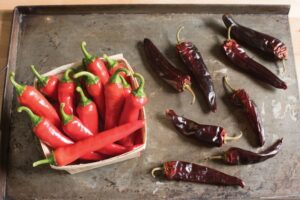Enjoy the spicy heat hot peppers add to your meals without concern for the many myths surrounding these garden vegetables. Here are a few you may have heard but are not true.
Growing both hot and sweet peppers in the garden will not add spicy heat to the sweet varieties. Peppers are normally self-pollinated. If an insect happens to move the pollen from a hot to sweet pepper, it will not affect the flavor or heat of this year’s harvest. If you save the seeds from a cross-pollinated pepper for next year’s garden there is no guarantee on the results. The offspring from this cross may be hot or sweet, only time will tell.
 Label hot peppers when growing, harvesting, and storing to avoid any mix-ups. The sweet banana pepper, for example, can easily be confused with hot banana. This makes for an unwelcome surprise when preparing, serving, and eating.
Label hot peppers when growing, harvesting, and storing to avoid any mix-ups. The sweet banana pepper, for example, can easily be confused with hot banana. This makes for an unwelcome surprise when preparing, serving, and eating.
Consider wearing rubber gloves and avoid touching your face and eyes when working with hot peppers as they can burn. Wash your hands, utensils and cutting boards when finished to avoid any future issues.
Never assume all green peppers are sweet or you will be in for a surprise. Jalapenos are typically harvested when green and others like habanero and Anaheim are hot, whether harvested when green or red. You will also find that hot peppers can be yellow, orange, brown and of course red.
You can turn down the heat when preparing your favorite recipes. Contrary to popular belief, all the heat in hot peppers does not come from the seeds. While partially true, the majority of the capsaicin that gives hot peppers their heat is in the white membrane that houses the seeds. When the seeds are growing, they may also be coated with extra capsaicin. Remove the white membrane and the seeds, just to be safe, if you want to turn down the heat.
The spicy heat of hot peppers is measured in Scoville Heat Units. The ratings are based on the amount of sugar water needed to neutralize the spicy heat in the extracted capsaicin that has been diluted in alcohol. A panel of five taste testers decides when the spicy heat has been neutralized and then assigns the rating. Today many companies use a chemical process (liquid chromatography) but translate their results into the popular Scoville Heat Units.
The Scoville Heat Unit rankings vary from one type of hot pepper to another with Poblano-Ancho rating between 1,000 to 2,000, jalapenos 2,500 to 6,000, habaneros at 100,000 to 300,000 and one of the hottest, the ghost pepper, at 1,000,000 to 2,200,000 Scoville Heat Units. Ratings may also vary from individual plants within a specific type based on individual plant differences and the growing conditions.
Finally, do not worry if you had a bad day when planting your hot peppers. Contrary to some old adages, planting hot peppers when angry will not make the peppers hotter, but unknowingly taking a bite of a hot pepper may very well change your mood.
Melinda Myers is the author of more than 20 gardening books, including Small Space Gardening. She hosts The Great Courses “How to Grow Anything” DVD series and the nationally-syndicated Melinda’s Garden Moment TV & radio program. Myers is a columnist and contributing editor for Birds & Blooms magazine and her web site is www.MelindaMyers.com.
